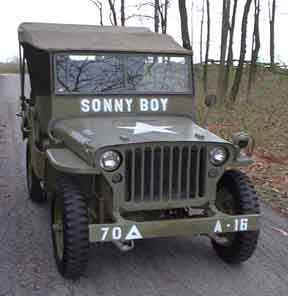
Willys MB

Willys MB

Willys MB

The Willys MB US Army Jeep, along with the nearly identical Ford GPW, was manufactured from 1941 to 1945. The small four-wheel drive utility vehicles are considered the iconic World War II Jeep, and would inspire many similar Light Utility Vehicles. Over the years, the World War II Jeep later evolved into "CJ" civilian Jeep and has been recognized as a symbol of rugged individualism in twentieth century American History. Its counterpart in the German army was the Volkswagen Kübelwagen, also based on a small automobile, but which used an air-cooled engine and lacked 4 wheel drive.
By July 1941, the War Department desired to standardize and decided to select a single manufacturer to supply them with the next order for another 16,000 vehicles. Willys won the contract mostly due to its more powerful engine (the "Go Devil") which soldiers raved about, and its lower cost and silhouette. Whatever better design features the Bantam and Ford entries had were then incorporated into the Willys car, moving it from an "A" designation to "B", thus the "MB" nomenclature.
By October 1941, it became apparent Willys-Overland could not keep up with production demand and Ford was contracted to produce them as well. The Ford car was then designated GPW, with the "W" referring to the "Willys" licensed design. During World War II, Willys produced 363,000 Jeeps and Ford some 280,000. Approximately 51,000 were exported to the USSR under the Lend-Lease program.
A further 13,000 (roughly) amphibian jeeps were built by Ford under the name GPA (nicknamed 'Seep' for Sea Jeep). Inspired by the larger DUKW, the vehicle was produced too quickly and proved to be too heavy, too unwieldy, and of insufficient freeboard. In spite of participating successfully in the Sicily landings (July 1943) most GPAs were routed to the USSR under the Lend-Lease program. The Soviets were sufficiently pleased with its ability to cross rivers to develop their own version of it after the war.
By July 1941, the War Department desired to standardize and decided to select a single manufacturer to supply them with the next order for another 16,000 vehicles. Willys won the contract mostly due to its more powerful engine (the "Go Devil") which soldiers raved about, and its lower cost and silhouette. Whatever better design features the Bantam and Ford entries had were then incorporated into the Willys car, moving it from an "A" designation to "B", thus the "MB" nomenclature.
By October 1941, it became apparent Willys-Overland could not keep up with production demand and Ford was contracted to produce them as well. The Ford car was then designated GPW, with the "W" referring to the "Willys" licensed design. During World War II, Willys produced 363,000 Jeeps and Ford some 280,000. Approximately 51,000 were exported to the USSR under the Lend-Lease program.
A further 13,000 (roughly) amphibian jeeps were built by Ford under the name GPA (nicknamed 'Seep' for Sea Jeep). Inspired by the larger DUKW, the vehicle was produced too quickly and proved to be too heavy, too unwieldy, and of insufficient freeboard. In spite of participating successfully in the Sicily landings (July 1943) most GPAs were routed to the USSR under the Lend-Lease program. The Soviets were sufficiently pleased with its ability to cross rivers to develop their own version of it after the war.
No comments:
Post a Comment